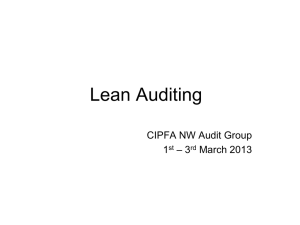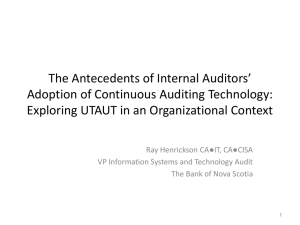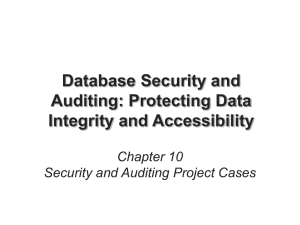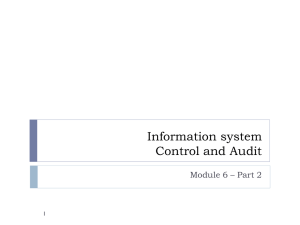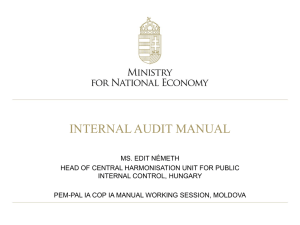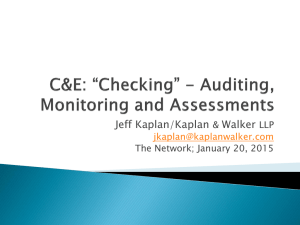Auditing Database Activities
advertisement
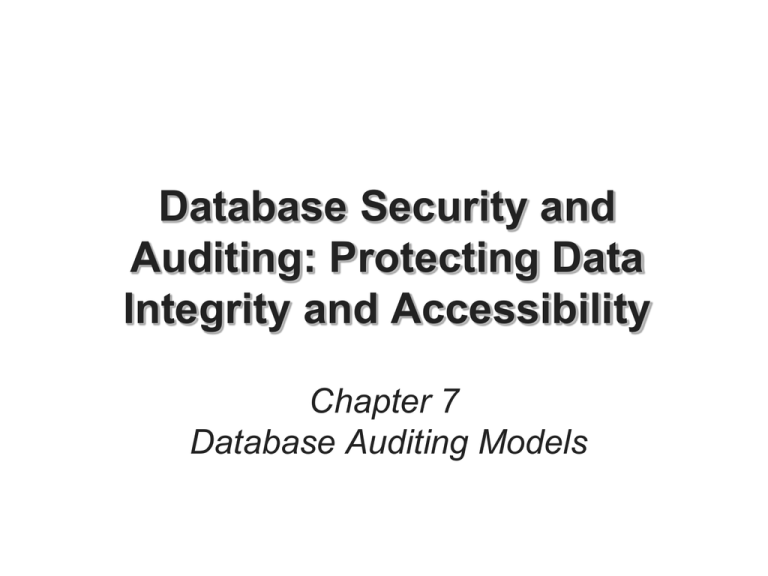
Database Security and Auditing: Protecting Data Integrity and Accessibility Chapter 7 Database Auditing Models Auditing Overview • Audit examines: documentation that reflects (from business or individuals); actions, practices, conduct • Audit measures: – compliance to policies, – procedures, – processes and laws Database Security & Auditing: Protecting Data Integrity & Accessibility 2 Definitions • Audit/auditing: process of examining and validating documents, data, processes, procedures, systems • Audit log: document that contains all activities that are being audited ordered in a chronological manner • Audit objectives: set of business rules, system controls, government regulations, or security policies Database Security & Auditing: Protecting Data Integrity & Accessibility 3 Definitions (continued) • Auditor: a person authorized to audit • Audit procedure: set of instructions for the auditing process • Audit report: a document that contains the audit findings • Audit trail: chronological record of document changes, data changes, system activities, or operational events Database Security & Auditing: Protecting Data Integrity & Accessibility 4 Definitions (continued) • Data audit: chronological record of data changes stored in log file or database table object • Database auditing: chronological record of database activities • Internal auditing: examination of activities conducted by staff members of the audited organization • External auditing Database Security & Auditing: Protecting Data Integrity & Accessibility 5 Auditing Activities • Identify security issues that must be addressed • Establish plans, policies, and procedures for conducting audits • Organize and conduct internal audits • Ensure all contractual items are met by the organization being audited • Act as liaison between the company and the external audit team • Provide consultation to the Legal Department Database Security & Auditing: Protecting Data Integrity & Accessibility 6 Auditing Process • Auditing process: ensures that the system is working and complies with the policies, regulations and laws • Auditing process is done after the product is commissioned into production. Database Security & Auditing: Protecting Data Integrity & Accessibility 7 Auditing Process (continued) • Auditing process flow: – System development life cycle – Auditing process: • Understand the objectives • Review, verify, and validate the system • Document the results Database Security & Auditing: Protecting Data Integrity & Accessibility 8 Auditing Process (continued) Database Security & Auditing: Protecting Data Integrity & Accessibility 9 Auditing Objectives • Part of the development process of the entity to be audited • Reasons: – – – – Complying Informing Planning Executing Database Security & Auditing: Protecting Data Integrity & Accessibility 10 Auditing Objectives • Database auditing objectives: – Data integrity – Application users and roles – Data confidentiality – Access control – Data changes – Data structure changes – Database or application availability – Change control –Auditing reports Database Security & Auditing: Protecting Data Integrity & Accessibility 11 Audit Classifications • Internal audit: – Conducted by a staff member of the company being audited – Purpose: • Verify that all auditing objectives are met • Investigate a situation prompted by an internal event or incident • Investigate a situation prompted by an external request Database Security & Auditing: Protecting Data Integrity & Accessibility 12 Audit Classifications (continued) • External audit: – Conducted by a party outside the company that is being audited – Purpose: • Investigate the financial or operational state of the company • Verify that all auditing objectives are met Database Security & Auditing: Protecting Data Integrity & Accessibility 13 Audit Classifications (continued) • Automatic audit: – Prompted and performed automatically (without human intervention) – Used mainly for systems and database systems – Administrators read and interpret reports; inference engine or artificial intelligence • Manual audit: performed completely by humans • Hybrid audit Database Security & Auditing: Protecting Data Integrity & Accessibility 14 Audit Types • Financial audit: ensures that all financial transactions are accounted for and comply with the law • Security audit: evaluates if the system is secure • Compliance audit: system complies with industry standards, government regulations, or partner and client policies Database Security & Auditing: Protecting Data Integrity & Accessibility 15 Benefits and Side Effects of Auditing • Benefits: – Enforces company policies and government regulations and laws – Lowers the incidence of security violations – Identifies security gaps and vulnerabilities – Provides an audit trail of activities – Provides means to observe and evaluate operations of the audited entity – Makes the organization more accountable Database Security & Auditing: Protecting Data Integrity & Accessibility 16 Benefits and Side Effects of Auditing (continued) • Side effects: – – – – Performance problems Too many reports and documents Disruption to the operations of the audited entity Consumption of resources, and added costs from downtime – Friction between operators and auditor – Same from a database perspective Database Security & Auditing: Protecting Data Integrity & Accessibility 17 Auditing Models • Can be implemented with built-in features or your own mechanism • Information recorded: – State of the object before the action was taken – Description of the action that was performed – Name of the user who performed the action Database Security & Auditing: Protecting Data Integrity & Accessibility 18 Auditing Models (continued) User-name Action Object Previous values and record Database Security & Auditing: Protecting Data Integrity & Accessibility 19 Simple Auditing Model 1 • Easy to understand and develop • Registers audited entities in the audit model repository • Chronologically tracks activities performed • Entities: user, table, or column • Activities: DML transaction (update, insert, delete) or logon and off times • Status: active, deleted, inactive Database Security & Auditing: Protecting Data Integrity & Accessibility 20 Simple Auditing Model 1 (continued) user, table, or column active, deleted, inactive Database Security & Auditing: Protecting Data Integrity & Accessibility update, insert, delete, logon and off 21 Simple Auditing Model 1 (continued) • Control columns: – Placeholder for data inserted automatically when a record is created or updated (date and time record was created and updated) – Can be distinguished with a CTL prefix Database Security & Auditing: Protecting Data Integrity & Accessibility 22 Simple Auditing Model 1 (continued) Database Security & Auditing: Protecting Data Integrity & Accessibility 23 Simple Auditing Model 2 • Only stores the column value changes • There is a purging and archiving mechanism; reduces the amount of data stored • Does not register an action that was performed on the data • Ideal for auditing a column or two of a table Database Security & Auditing: Protecting Data Integrity & Accessibility 24 Simple Auditing Model 2 (continued) A list of columns to be audited Database Security & Auditing: Protecting Data Integrity & Accessibility 25 Historical Data Model • Used when a record of the whole row is required • Typically used in most financial applications Database Security & Auditing: Protecting Data Integrity & Accessibility 26 Historical Data Model (continued) Database Security & Auditing: Protecting Data Integrity & Accessibility 27 Auditing Applications Actions Model • Used to audit specific operations or actions. • You may want to audit a credit to an invoice, the reason for it being credited, the person who credited it, and the time it was credited. Database Security & Auditing: Protecting Data Integrity & Accessibility 28 C2 Security • C2 security is a government rating for security in which the system has been certified for discretionary resources protection and auditing capabilities. • SQL server has a C2 certification, but this certification is only valid for a certain evaluated configuration. • You must install SQL server in accordance with the evaluated configuration. Database Security & Auditing: Protecting Data Integrity & Accessibility 29 C2 Security Requirements • A system must be able to identify a user. – Implement the notion of user credentials (e.g., username and a password) – Require a user to login using this credentials – Have a well-defined process by which a user enters these credentials, – Protect these credentials from capture by an attacker. • Users are accountable for their activities – Audit any user activity. • An owner of an object can grant permissions for access to the object for other users or groups. (what discretionary means) Database Security & Auditing: Protecting Data Integrity & Accessibility 30 C2 Security • If all auditing counters are turned on for all objects, there could be a significant performance impact on the server. • References: Implementing Database Security and Auditing By Ron Ben-Natan, Chapter 1, page 33-34 Database Security & Auditing: Protecting Data Integrity & Accessibility 31 DML Action Auditing Architecture • Data Manipulation Language (DML): companies use auditing architecture for DML changes • DML changes can be performed on two levels: – Row level – Column level • Fine-grained auditing (FGA) Database Security & Auditing: Protecting Data Integrity & Accessibility 32 DML Action Auditing Architecture (continued) Database Security & Auditing: Protecting Data Integrity & Accessibility 33 DML Action Auditing Architecture (continued) Database Security & Auditing: Protecting Data Integrity & Accessibility 34 Oracle Triggers • Stored PL/SQL procedure executed whenever: – DML operation occurs – Specific database event occurs • Six DML events (trigger timings): INSERT, UPDATE, and DELETE • Purposes: – Audits, controlling invalid data – Implementing business rules, generating values Database Security & Auditing: Protecting Data Integrity & Accessibility 35 Oracle Triggers (continued) Database Security & Auditing: Protecting Data Integrity & Accessibility 36 Oracle Triggers (continued) • CREATE TRIGGER • Executed in a specific order: – STATEMENT LEVEL triggers before COLUMN LEVEL triggers – BEFORE triggers before AFTER triggers • USER_TRIGGERS data dictionary view: all triggers created on a table • A table can have unlimited triggers: do not overuse them Database Security & Auditing: Protecting Data Integrity & Accessibility 37 Oracle Triggers (continued) Database Security & Auditing: Protecting Data Integrity & Accessibility 38 Fine-grained Auditing (FGA) with Oracle • Oracle provides column-level auditing: Oracle PL/SQL-supplied package DBMS_FGA • DBMS_FGA procedures: – – – – ADD_POLICY DROP_POLICY DISABLE_POLICY ENABLE_POLICY Database Security & Auditing: Protecting Data Integrity & Accessibility 39 Fine-grained Auditing (FGA) with Oracle (continued) • ADD_POLICY parameters: – – – – – – – – – OBJECT_SCHEMA OBJECT_NAME POLICY_NAME AUDIT_CONDITION AUDIT_COLUMN HANDLER_SCHEMA HANDLER_MODULE ENABLE STATEMENT_TYPES • DBA_FGA_AUDIT_TRAIL: view the audit trail of the DML activities Database Security & Auditing: Protecting Data Integrity & Accessibility 40 DML Action Auditing with Oracle • Record data changes on the table: – Name of the person making the change – Date of the change – Time of the change • Before or after value of the columns are not recorded Database Security & Auditing: Protecting Data Integrity & Accessibility 41 DML Action Auditing with Oracle (continued) Database Security & Auditing: Protecting Data Integrity & Accessibility 42 DML Action Auditing with Oracle (continued) • Steps: – Use any user other than SYSTEM or SYS; with privileges to create tables, sequences, and triggers – Create the auditing table – Create a sequence object – Create the trigger that will record DML operations – Test your implementation Database Security & Auditing: Protecting Data Integrity & Accessibility 43 History Auditing Model Implementation Using Oracle • Historical data auditing is simple to implement; main components are TRIGGER objects and TABLE objects • Keeps record of: – Date and time the copy of the record was captured – Type of operation applied to the record Database Security & Auditing: Protecting Data Integrity & Accessibility 44 History Auditing Model Implementation Using Oracle (continued) • Steps: – Use any user other than SYSTEM or SYS; with privileges to create tables, sequences, and triggers – Create history table – Create the trigger to track changes and record all the values of the columns – Test your implementation Database Security & Auditing: Protecting Data Integrity & Accessibility 45 Project 6: Auditing • Report your experiences on using fine-grained auditing. • http://www.oracle.com/technetwork/articles/idm/ fga-otn-082646.html Database Security & Auditing: Protecting Data Integrity & Accessibility 46 Summary • Audit examines, verifies and validates documents, procedures, processes • Auditing environment consists of objectives, procedures, people, and audited entities • Audit makes sure that the system is working and complies with the policies, standards, regulations, and laws • Auditing objectives established during development phase Database Security & Auditing: Protecting Data Integrity & Accessibility 47 Summary (continued) • Objectives: compliance, informing, planning, and executing • Classifications: internal, external, automatic, manual, hybrid • Models: Simple Auditing 1, Simple Auditing 2, Advanced Auditing, Historical Data, Auditing Applications, C2 Security Database Security & Auditing: Protecting Data Integrity & Accessibility 48
